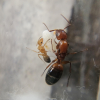Sweet, thanks guys. I may do that in the colder months then.
A lot of ants could technically benefit from a heat gradient in the warmer months as well. Just make sure it's not in a place where they can't get away from it if they need to. I like to drape mine over one side of the nest so they can either be right by it, or go all the way to the other side if they don't like it.
Sometimes they'll only keep brood by it, to accelerate their growth.
Just be mindful, if your ants look like they don't really like it and are avoiding it, you can take it off. From my experience, however, they are usually at the halfway point or directly at the heat cable. Some species like less heat, some want more. I haven't found one that doesn't like it at all, though.
For test tubes, I typically just run it horizontally across the front of the tube, right before or right over the cotton. For species that want more heat, I run it across more toward the center of the founding chamber part of the tube.
Just play around with it and see

(Again, just be sure to be mindful and not to cook your ants! 15w heating cables are the standard, don't get anything that puts out more than that!)

















